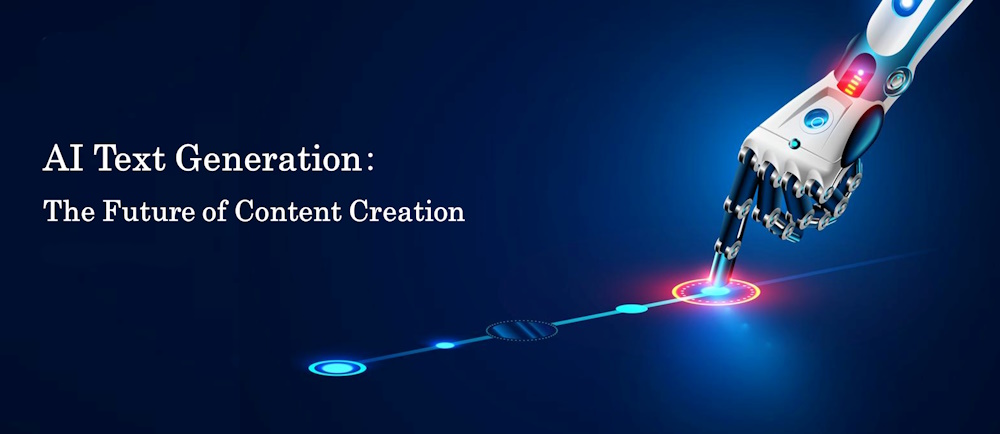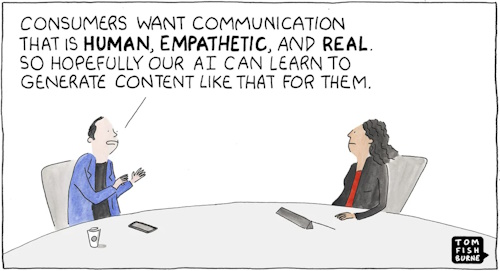 AI Text Generators
AI Text Generators
Advanced tools that use AI to create human-like written content
Related: Chatbots | Prompt Engineering | ChatGPT | Gemini | Copilot | Claude | Grok
AI text generators are tools powered by machine learning and natural language processing that produce human-like written content. These tools can generate text for a variety of applications, ranging from creative writing to business communications to technical documentation, and more.
AI text generators are trained on vast datasets of text from books, articles, and websites. They use advanced language models like GPTs to understand patterns and context, and they generate text by predicting the words most likely to be next based on the input prompt.
 Popular Products
Popular Products
ChatGPT: The GPT models, including GPT-3 and GPT-4, are some of the most well-known AI text generators. They can perform a wide range of tasks, from answering questions to writing essays and generating creative content. They feature onversational abilities, creative content, and programming assistance, and are used for blog posts, marketing copy, coding, customer service, and more. GPT-3.5 and GPT-4 models have web browsing and plugin capabilities. There are both free and paid tiers.

Gemini: Multiple sizes (Ultra, Pro, Nano). Gemini has multimodal capabilities and is integrated into Google products, especially Google Search. The model is designed to assist with various tasks, including summarization, translation, and generating text. There is access to real-time web data for dynamic and factual text generation. It is used for summaries, research, answering complex queries, and more. AI Overviews, powered by Gemini, appears on most Google web searches.
Claude: Claude 3 family (Opus, Sonnet, Haiku). It has a special focus on safety and reasoning and is available via web, API, and integrations.
Grok: Grok is designed to provide truthful, useful, and curious responses, competing with other major AI text generators.
Cohere: The focus is on enterprise solutions and natural language processing. It is used for semantic search, summarization, and chatbot content.
Copy.ai: It is optimized for creating copy quickly and is used for headlines, taglines, and advertising content.
Jasper AI: Jasper is a specialized tool for marketing and e-commerce copy. It can be used for product descriptions, ad copy, email templates.
Hugging Face: Hugging Face offers a range of pre-trained models or transformers that can be fine-tuned for specific tasks, such as text generation, sentiment analysis, and more.
Llama from Meta: An open source foundation model with multiple versions and is used as base for other models.
Mistral AI: Mistral has open source and commercial models. It has an efficient training approach. Multiple model sizes are available.
Writesonic: Featuring a budget and user-friendly interface, it is used for social media posts, blog outlines, email campaigns.
 How They Work
How They Work
At the core of most AI text generators are large language models that are trained on vast datasets to predict and produce text that mimics human writing styles. AI text generators use natural language processing to understand and generate the human-like text. This activity involves processing the input text, understanding the context, and producing coherent responses. These tools are built on machine learning models, such as generative pre-trained transformers, which are trained on accumulated datasets to learn language patterns and generate text. Advanced AI text generators can maintain context over long conversations, making their responses more relevant and natural.
 Key Features
Key Features
AI text generators can help overcome writer's block and generate ideas, and they can assist in drafting, editing, and revising text. Real-time writing assistance and grammar checking are available from tools like Grammarly's AI writer or Jasper AI, which provide features for rephrasing sentences, creating outlines, and producing complete documents. They can maintain a consistent tone and style, which is especially useful for ventures like branding and marketing.
AI text generators can produce various forms of written content including
articles, blog posts, social media posts, emails, and even creative writing like
stories and poems. They are used in marketing, journalism, education, and
entertainment to generate original content or assist in the writing process.
There are templates available for different content types such as social media
posts and articles.
With fine-tuning, businesses can adapt AI text generators for specific
industries or brands.
AI text generators can produce content quickly, saving time and resources. Some AI text generators can translate text into different languages, aiding in global communication and content localization. Models can comprehend user input and generate contextually relevant responses.
AI text generators allow businesses to scale their content production without a proportional increase in costs. Writing styles can be adjusted to fit casual, professional, or creative needs. They support both multiple languages and technical jargon. They can be fine-tunied for specific tasks or industries.
 Applications
Applications
- Business Communications: Drafting emails, reports, and presentations.
- Content Creation: Businesses use AI to generate blog posts, social media content, and marketing copy. Generating articles, essays, marketing documents, social media, posts, creative stories.
- Creative Writing: AI text generators can help authors brainstorm ideas, generate storylines, poems, and even write entire chapters.
- Customer Support: AI chatbots powered by text generators can handle customer inquiries, providing quick and accurate responses.
- Data Analysis: AI text generators can summarize reports, generate insights from data, and create detailed analyses.
- Education: AI can assist students and educators by generating study materials, answering questions, and providing tutoring. Summarizing texts, creating study guides, or assisting with language learning.
- Entertainment: Writing scripts, poetry, or game dialogues.
- Marketing and Advertising: Writing slogans, ad campaigns, and product descriptions.
- Programming: Generating code snippets and documentation.
 Limitations
Limitations
AI text generators lack original insight so they may not produce truly innovative ideas. They sometimes produce incorrect or fabricated information, called hallucinations, and they can replicate biases present in training data, passing biased information along to users. Being dependant on prompts, the quality of the output often depends on the clarity and specificity of user inputs.
To overcome the limitations of AI text generators, users should focus on providing clear prompts and supplement AI with human creativity. Provide clear prompts by being specific and detailed about what you want. It helps to include the context, the desired tone, and the target audience. Review and edit outputs by verifying facts and refining the text for coherence and consistency. You can train the AI with your own datasets for tailored, custom results. Finally, it can be helpful to combine AI with your creativity, like using AI as a starting point and continually enhance the content by applying your knowledge and experience.
 Future Trends
Future Trends
As AI models evolve, they're expected to provide even more nuanced and contextually accurate text, potentially challenging human writers in some fields. Future AI text generators might offer more customization options to match individual writing styles or institutional tones, thereby making them more versatile for personal and professional use.
In the future, expect improved real-time capabilities, integrating information in datasets with live data sources to produce more up-to-date outputs. Google and Microsoft should lead the way since they can tap into their extensive search bases. Models are constantly stiving for ethical safeguards by reducing biases and becoming more transparent. AI models will become more specialized, with particular attention to industries like medicine, law, and finance. Another ongoing project is interactive content creation where AI will collaborate with users in a more interactive manner.
Work is underway to enhance the accuracy, creativity, and versatility of AI text generators. For instance, OpenAI's updates to ChatGPT and Google's developments with Gemini models show advancements in content composition and conversational abilities. AI text generators are becoming more integrated into everyday tools like Microsoft Word, Google Docs, and specialized platforms like Notion with Notion AI. This integration aims to streamline workflows and make AI assistance more accessible. Also, new and improved models are being developed for specific tasks, like generating code, creating legal documents, and even crafting personalized stories with models like Hermes 3.

 Challenges
Challenges
- Dependency: Over-reliance on AI for content creation can stifle human creativity and originality.
- Ethical Considerations: Addressing the ethical implications of AI-generated content, including plagiarism and the potential for misuse.
- Ethical and Legal Issues: There are concerns about copyright infringement, as these models are often trained on existing text, including copyrighted material. Additionally, there's debate over the ethical implications of AI in creative industries.
- Quality Control: While AI can generate text quickly, ensuring the quality, accuracy, and lack of bias in the output remains a challenge. AI generators might sometimes produce content that sounds plausible but could be factually incorrect or culturally insensitive if not monitored. Ensuring the generated text meets quality standards and is free from biases or inaccuracies is key.
 Chatbots versus AI Text Generators
Chatbots versus AI Text Generators
What is the difference between an AI chatbot and an AI text generator?
The distinction between a chatbot and an AI text generator lies in their primary functions and use cases. Both technologies have their unique strengths and applications, and often, the lines between them can blur, especially as AI continues to evolve.
Chatbot
A chatbot is a specialized AI application designed to simulate human conversation, primarily through text or voice interactions. The main goal of a chatbot is to engage in real-time dialogues with users, providing answers, assistance, or performing specific tasks. Chatbots are often interactive and responsive, maintaining context over a conversation to offer relevant responses. Chatbots can be rule-based (following pre-defined scripts) or use advanced AI and NLP (Natural Language Processing) to understand and generate responses. Examples of chatbots are customer support bots, virtual assistants (like Siri or Google Assistant), and messaging bots used in apps like Facebook Messenger or WhatsApp.
AI Text Generator
An AI text generator is a broader AI application designed to create written content based on user inputs, often leveraging complex language models. The primary goal is to generate coherent and contextually relevant text for various tasks such as content creation, summarization, or creative writing. AI text generators may not always maintain an interactive dialogue, but instead focus on producing longer, more detailed text outputs based on prompts. These systems use advanced machine learning models trained on vast datasets to learn language patterns and generate human-like text. Examples include ChatGPT, Gemini, and other language models used for generating essays, stories, code or answering questions in detail.
Chatbots are designed for interactive communication, while AI text generators focus on producing extended text content. Chatbots are commonly used for customer service, virtual assistance, and real-time interaction. AI text generators are used for content creation, writing assistance, and data analysis. Chatbots maintain a conversational flow, often asking follow-up questions to keep the dialogue going. AI text generators respond to specific prompts without necessarily engaging in an ongoing conversation.
 Links
Links
speechify.com/blog/ai-generator-text/
aidocmaker.com/blog/how-does-ai-text-generation-work
ai-pro.org/learn-ai/articles/a-complete-guide-to-ai-text-generators/
annotationbox.com/complete-guide-on-generative-ai-text-models/
narrato.io/blog/what-is-an-ai-text-generator-how-to-use-ai-text-generators-for-marketing-content/
edenai.co/post/mastering-ai-text-generation-a-comprehensive-guide-to-creating-accurate-content
castos.com/ai-text-generators/
research.aimultiple.com/ai-text-generation/
zapier.com/blog/ai-text-generator/
semrush.com/contentshake/ai-text-generator/